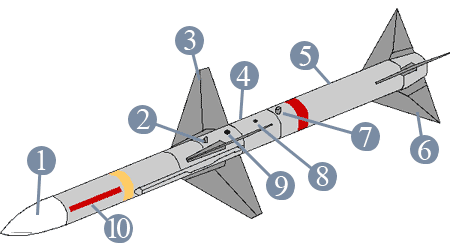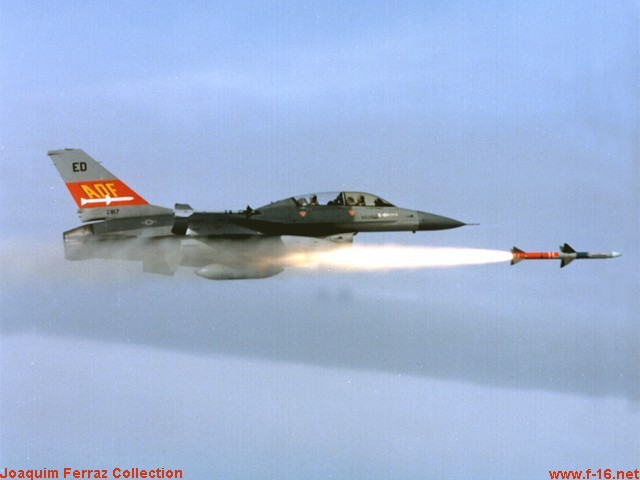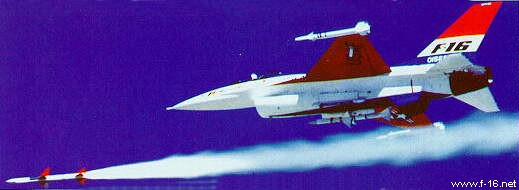 |
AIM-7 SparrowMedium Range Air-to-Air Missile |
Introduction
The AIM-7 Sparrow is a supersonic, medium-range, air-to-air missile. It has a high-explosive warhead and is guided by RF-signals received from the launching aircraft. The missile also excists in a ship-based intercept version where it is designated RIM-7 Sea Sparrow.
History
The development of this BVR-missile started as early as 1946 in a project called 'Hotshot'. This program intended to design a missile which was capable of intercepting high performance enemy targets at medium-range. The first firing of the missile took place in December 1952, designated as AAM-N-2. The missile reached IOC in late 1953 and entered service in 1956 with F3H-2M 'Demon' and F7U-3M 'Cutlass' fighters
During the years a lot of difficulties arose with the operational capabilities of the missiles. During their deployment with the F-4 fighter in the Vietnam theatre they seemed vitually useless against fast-moving highly maneuverable opponents. To counter this disadvantage a special dogfight missile was developed.The F-16 was never intended to carry the Sparrow missile because it was designed to be a short range day-time interceptor without any BVR capabilities. Although the possibility of equipping the aircraft with the missile were already tested succesfully in 1977 it took untill the introduction of the F-16C block 25 and the F-16 ADF before the Viper got a BVR capability.
Construction
The Sparrow has a cilindrical body with four wings at mid-body and four tail fins. The missile is divided into four assemblies, namely radar guidance system, warhead, flight control and solid-propellant rocket motor.

- Key to drawing:
- Radome
- Forward suspension lug
- Wings
- Control section
- Rocket motor
- Fins
- Aft suspension lug
- Connector
- 1760 interface
- Guidance section
The radar guidence system processes radar signals received from the launch aircraft's radar via its rear signal receiver, and also processes RF energy reflected from the target received by its own internal radar receiver. The missile is detonated with an active RF fuze when it comes within range of the projected target. The missile is controlled by the flight control system via four movable delta wings and overall stability is provided by four fixed delta fins which are located in line with the forward wings. The solid-propellant rocket motor provides the missile's propulsion.
Versions
AIM-7A
Original design for use with the F3H-2M 'Demon' and F7U-3M 'Cutlass' fighters. The missile was equipped with a beam-riding guidence system which gave it a poor low-level performance and necessitated a visual identification of the target, making the missile not a BVR but VFR missile. This caused the missile to be withdrawn within a few years of service.
AIM-7B
Intended for use with the Douglas F5D 'Skylancer' fighter and the Canadian CF-105 'Arrow' fighter but cancelled in 1958.
AIM-7C
The missile was equipped with a semi-active homing radar. It featured a 65 lb (30 kg) MK 38 continuous-rod warhead and was propelled with a solid-fueled rocket engine.
AIM-7D
An AIM-7C with a new Thiokol LR44-RM-2 storable liquid-propellant rocket engine and an improved guidance system for better anti-jamming performances.
AIM-7E, AIM-7E-2, AIM-7E-3, AIM-7E-4, RIM-7E
Introduced in 1963 and heavily used in Vietnam in conjunction with the venerable F-4 'Phantom'. It featured a new propulsion system based on a solid-fueled rocket which gave the missile an increased range and performance. This increased performance could not be exploited to full extend due to limited IFF capabilities which required a visual identification of the target. This led to the development of the AIM-7E-2 which had a shorter minimum range and clipped wings for better manoeverability. The AIM-7E-3 had higher reliability and the AIM-7E-4 was specially adapted for use with high-power fighter radars (like the F-14's AN/AWG-9).In 1967 a derivative of the missile was developped for use on ships to provide them with a missile based anti-aircraft defence system. This missile was known as RIM-7E Sea Sparrow. The missile was essentially an unchanged AIM-7E and was fired from a modified ASROC launcher.
AIM-7F, RIM-7F
Introduced in 1972, featuring a radical improvement over previous versions. Equipped with a dual-trust rocket motor for increased range and a completely new electronic guidance and control system compatible with pulse-doppler radars.
The RIM-7F Sea Sparrow was the ship-launched equivalent of the AIM-7F. The missile was relatively short-lived because further development was cancelled in favor of a ship-launched derivative of the AIM-7M, the RIM-7M.
AIM-7G
Designed for use with the F-111D 'Aardvark' but never taken into production.
RIM-7H
The RIM-7H was a basic RIM-7E missile better adapted for shipboard use. It featured folding fins to fit into more compact MK 29 launchers. Because it was essentially similar to the AIM/RIM-7E, therefore it was less advanced than the RIM-7F. The RIM-7H is the missile used in the NATO Sea Sparrow Missile System (NSSMS) Block I.
AIM-7M, RIM-7M
Entered production in 1982 and features a new inverse monopulse seeker for look-down/shoot-down capability, a digital computer, an autopilot and an new WDU-27/B blast-fragmentation warhead.
The RIM-7M Sea Sparrow is the ship-launched equivalent of the AIM-7M. In addition to the 8-cell MK 29 box launcher, the RIM-7M missiles can also be fired from MK 41 (AEGIS) and MK 48 VLS (Vertical Launch System) launchers.
AIM-7N
Designed for use with the F-15 MSIP (Multi Stage Improvement Program) but never taken into production.AIM-7P, RIM-7P
Entered production in 1987, the AIM-7P is an improved AIM-7M. It features improved guidance electronics and on-board computer and has an uplink to the autopilot for mid-course guidance updates. There are two subvariants of the AIM-7P, known as Block I and Block II. The AIM-7P Block I has a WGU-6D/B guidance section, and the Block II uses a WGU-23D/B guidance section.
AIM-7R, RIM-7R
The AIM-7R was developed in the early 1990s as an improved AIM-7P Block II. It would feature a new dual mode (Radar/IR) seeker developed under the MHIP (Missile Homing Improvement Program). An equivalent ship-launched version was projected as RIM-7R. Although it was initially planned to upgrade many AIM/RIM-7M/P rounds to AIM/RIM-7R standard, the -7R program was cancelled because of high costs in December 1996 after the evaluation phase was completed.
F-16 Installation
F-16 Loadout
On the F-16, AIM-7 Sparrows can be loaded on stations 3 and 7 (1 missile on each station). Other stations have been wired for testing purposes, but never on operational aircraft.
 |
 |
Operational Use
The first real use of the AIM-7 Sparrow occured in the Vietnam conflict, where it was heavily used by USAF and U.S. Navy F-4 Phantoms. The first engagement happened on June 7th 1965 when a U.S. Navy F-4B shot down 2 North Vietnamese MiG-17's. Although the missile was standard equipment on F-4's and used almost every day, the results were poor. Because of the absence of a reliable IFF system on the aircraft, the lang-range capacities of the AIM-7 could not be used, resulting in the missile being nothing more than a short-range radar guide missile. Kill-ratio of the first missiles never exceeded 10%.
Therefore a new missile was developed very quickly to overcome this shortfalls. This became the AIM-7E-2. With the introduction of the new missile overall effectiveness was improved and kill-ratios started to improve as well. With the ending of the conflict the total of confirmed kills stood at more than 50.
The last (up to now) operational use of the AIM-7 was in operation Desert Storm in 1991. The missile was used extensively by F-15 and F-16 aircraft. At the end of the war 22 Iraqi aircraft and 3 helicopters were downed by a AIM-7 missile.
The use of the missile will continue with different airforces around the world and will certainly stay in service aboard different naval vessels in the Sea Sparrow variant. However, the development of the missile has ceased in favor of the introduction of the AIM-120 AMRAAM missile. Although the AIM-7 was a splendid missile, it has one major disadvantage. Once it is fired, the aircraft must continue to illuminate the target untill impact, limiting that aircraft to straight and level flight.
For this reason the missile will slowly lose it's overall effectiveness and will be replaced completely with the AIM-120 AMRAAM or other medium to long range fire-and-forget missiles.
Specifications
Primary Function: Air-to-air missileContractor: Naval Weapons Center
Power Plant: Hercules and Bermite Mk 36 Mod 71, 8 solid-propellant rocket motor
Length: see table below
Launch Weight: see table below
Diameter: 8 inches (203 mm)
Wingspan: see table below
Range: see table below
Speed: see table below
Guidance System: Solid-state, infrared homing system
Warhead: Blast fragmentation, see table below
Unit Cost: $125,000 (FY 1999)
| Sparrow | Length (mm) | Wingspan (mm) | Control fin span (mm) | Launch Weight (kg) | Speed (mach) | Range (km) | Warhead (kg) | Production Run |
|---|---|---|---|---|---|---|---|---|
| AIM-7A | 3740 | 940 | 880 | 65 | 2.5 | 10 | 20 | 2,000 |
| AIM-7C | 3660 | 1020 | 810 | 78 | 4 | 11 | 30 | 2,000 |
| AIM-7D | 3660 | 1020 | 810 | 78 | 4 | 11 | 30 | 7,500 |
| AIM-7E | 3660 | 1020 | 810 | 89.5 | 4 | 30 | 30 | 25,000 |
| AIM-7F | 3660 | 1020 | 810 | 105 | 4 | 70 | 39 | 15,000+ |
| AIM-7H | 3660 | 1020 | 810 | 89.5 | 4 | 30 | 30 | 2,000+ |
| AIM-7M | 3660 | 1020 | 810 | 105 | 4 | 30 | 40 | 5,000+ |
| AIM-7P | 3660 | 1020 | 810 | 105 | 4 | 30 | 40 | ? |
Sources
- GlobalSecurity.org on AIM-7: http://www.globalsecurity.org/military/systems/munitions/aim-7.htm
- Designation-systems.net on AIM-7: http://www.designation-systems.net/dusrm/m-7.html
Please use this form to add any list any error or omissions you find in the above text.
Note: your comments will be displayed immediately on this page. If you wish to send a private comment to the webmasters, please use the Contact Us link.


